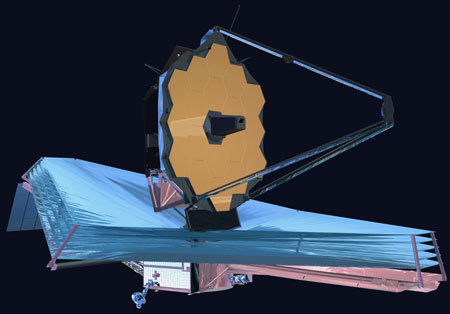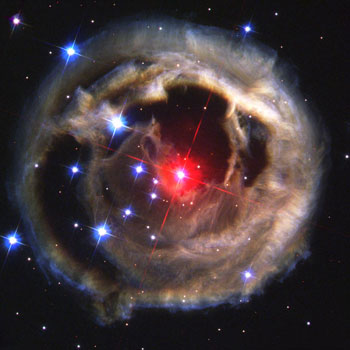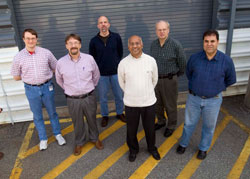A Bigger Chill
A Bigger Chill

An artist’s rendering of the James Webb Space Telescope. Image: NASA
Ultracold refrigeration helps Jefferson Lab scientists peer into the innermost spaces of everyday objects. This knowledge of cold is also used to help astronomers gaze deep into outer space.
Jefferson Lab’s Cryogenics Department staff members are designing a new refrigeration plant for NASA Johnson Space Center that will be used in testing components of the next space telescope. This new, single plant will triple the capacity of the current refrigeration system. The new plant is also likely to be the first built using the award-winning, energy-saving floating pressure Ganni Cycle technology developed at Jefferson Lab.
For years, the Hubble Space Telescope has collected remarkable images of our universe, helping to answer some of astronomy’s toughest questions. But the aged satellite is set to wind down in 2013, and its replacement, the James Webb Space Telescope, is currently in development.
Jonathan Homan is a senior engineer in the Systems Test Branch of the Thermal Systems Division at Johnson Space Center. He is in charge of providing a cold environment in Johnson Space Center’s silo-shaped Space Simulation Chamber A for testing the new telescope’s imaging capabilities. The telescope has an array of instruments that are sensitive to infrared light, which we feel as heat.
“To look at light from the earliest galaxies, you have to look at ranges called mid- and near-infrared. And in those ranges, you have to use extremely cold instruments to capture that light and analyze it,” he says
Even though the craft will have a sunshield to block heat from the sun, its instruments will be exposed to heat from the spacecraft itself and from dust particles in space that reflect sunlight. Astronomers need to test how that heat will affect the instruments’ sensitivity.
The James Webb Space Telescope is designed for discovering and understanding the formation of the first stars and galaxies, measuring the geometry of the Universe and the distribution of dark matter, investigating the evolution of galaxies and the production of elements by stars, and the process of star and planet formation.
“There’s a thermal portion of the test that will look at things like thermal balancing on the spacecraft. Does the analysis that scientists have done predict what we're seeing in the test data? Are they seeing heat transfer as expected? Are they seeing thermal distortion where they think it's going to happen?” Homan explains. “They're testing all that in the chamber in flight-like conditions.”
Venkatarao (Rao) Ganni, Dana Arenius, Ahmed Sidi-Yekhlef, Jonathan Creel and the rest of the cryo group, all of Jefferson Lab, are helping NASA scientists design a cryogenics plant to cool the telescope’s components to temperatures its instruments will experience in space, roughly within 30 degrees Fahrenheit of absolute zero. The new plant will extend NASA’s space environment temperature capabilities in Chamber A (40 feet in diameter by 100 feet high) from about -315 degrees Fahrenheit (80-90 Kelvin) to a much lower -432 degrees Fahrenheit (15-20 Kelvin).
Rao Ganni, deputy Cryogenics Department head, is proud of the technical achievement the design represents. “In addition, the Chamber A liquid nitrogen shield cooling process will be converted from the original pumped system to a thermo siphon system similar to the JLab-designed 2K cold boxes,” Ganni says.
Homan and his colleagues chose Jefferson Lab’s Cryogenics Department because of its staff members’ extensive experience in designing, running and maintaining cryogenic refrigerator plants at these temperatures.
“We hadn't been able to find in industry that link between people who own and operate equipment and people who design and build equipment, and that's really what I was able to find with the cryogenics group at Jefferson Lab,” Homan says.

Observations by NASA's Hubble Space Telescope of a phenomenon called a "light echo" have uncovered remarkable new features. These details of a light echo from star V838 Monocerotis promise to provide astronomers with a CAT-scan-like probe of the three-dimensional structure of shells of dust surrounding an aging star. Image: NASA, ESA and H.E. Bond (STScI)
Dana Arenius, head of the Cryogenics Department, says his group began working with NASA in 2006. “Our role is to help them formulate their needs by developing the efficient processes and then develop the specifications, which they can use to secure the equipment they need,” Arenius says.
The procurement process has begun, with manufacturers already bidding on certain components. Interestingly, the new plant may be the first built to take full advantage of the floating pressure Ganni Cycle technology and other innovations developed by JLab staff, an exciting prospect for Ganni,
“The technology is constantly evolving, so we are open to new thoughts and new developments. We've established at this time this floating pressure Ganni Cycle as a benchmark. But we don't want the technology to stay right there, we want it to go even further than that,” Ganni says.
In the meantime, the group has also helped Johnson Space Center staff upgrade their existing 15-20K cryogenics plant. The improvements have dramatically improved NASA’s testing capabilities by coaxing more efficient and stable operation out of the systems.
During commissioning in February, NASA found that the upgrade dramatically reduced the fluctuations in refrigeration temperatures (variations were reduced from ±2.5 Kelvin to ±0.25 Kelvin). The changes also have improved system efficiency, startup reliability and simplified system monitoring, reduced liquid nitrogen requirements, and virtually eliminated two potential causes of damage to the system.
“This was a great opportunity to participate in a project with national importance which utilizes the Jefferson Lab technology, the floating pressure Ganni Cycle,” Arenius says.
In addition, the work is directly benefiting Jefferson Lab, particularly as staffers prepare for the 12 GeV Upgrade, which will require a doubling of the capabilities of the Lab’s cryogenics plant.
“It reinforces our ability and our knowledge of the state of the art the marketplace has to offer,” Arenius says.
For More information:
Jefferson Lab Innovation Saves $1,000/Day in Cooling Costs
DOE Innovative Energy Efficiency Initiatives
Brookhaven National Lab Bulletin
James Webb Space Telescope Home
JWST Mission Summary
Jefferson Lab is managed and operated for the U.S. Department of Energy's Office of Science by Jefferson Science Associates, LLC, a joint venture between Southeastern Universities Research Association, Inc. and CSC Applied Technologies Division, LLC.


